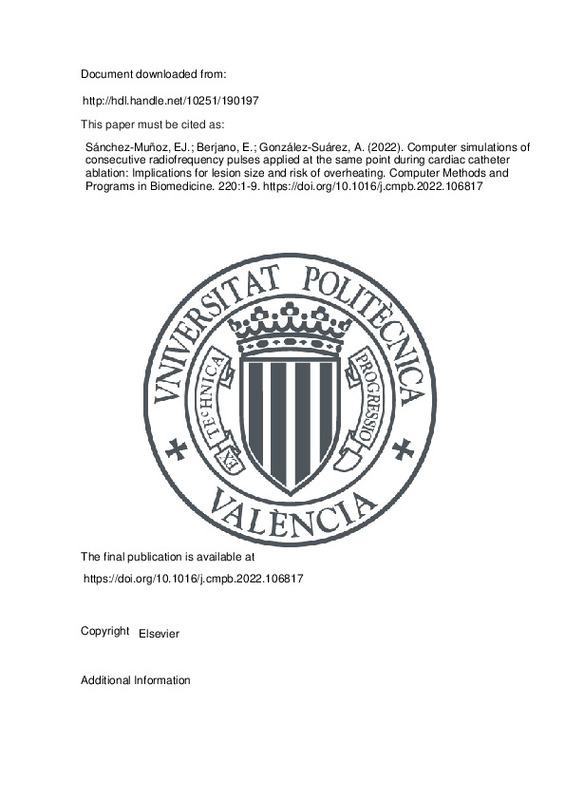JavaScript is disabled for your browser. Some features of this site may not work without it.
Buscar en RiuNet
Listar
Mi cuenta
Estadísticas
Ayuda RiuNet
Admin. UPV
Computer simulations of consecutive radiofrequency pulses applied at the same point during cardiac catheter ablation: Implications for lesion size and risk of overheating
Mostrar el registro sencillo del ítem
Ficheros en el ítem
| dc.contributor.author | Sánchez-Muñoz, Eugenio J.
|
es_ES |
| dc.contributor.author | Berjano, Enrique
|
es_ES |
| dc.contributor.author | González-Suárez, Ana
|
es_ES |
| dc.date.accessioned | 2022-11-25T19:01:56Z | |
| dc.date.available | 2022-11-25T19:01:56Z | |
| dc.date.issued | 2022-06 | es_ES |
| dc.identifier.issn | 0169-2607 | es_ES |
| dc.identifier.uri | http://hdl.handle.net/10251/190197 | |
| dc.description.abstract | [EN] Background and objectives: To study temperature distribution and lesion size during two repeated radiofrequency (RF) pulses applied at the same point in the context of RF cardiac ablation (RFCA). Methods: An in-silico RFCA model accounting for reversible and irreversible changes in myocardium electrical properties due to RF-induced heating. Arrhenius damage model to estimate lesion size during the application of two 20 W pulses at intervals (INT) of from 5 to 70 s. We considered two pulse durations: 20 s and 30 s. Results: INT has a significant effect on lesion size and maximum tissue temperature (TMAX). The shorter the INT the greater the increase in lesion size after the second pulse but also the greater the TMAX. If the second pulse is applied almost immediately (INT = 5 s), depth increases 1.4 mm and 1.5 mm for pulses of 20 s and 30 s, respectively. If INT is longer than 30 s it increases 1.1 mm and 1.3 mm for pulses of 20 s and 30 s, respectively. While a single 20 s pulse causes T MAX = 79 4C, a second pulse produces values of from 92 to 96 4C (the higher the temperature the shorter the INT). For 30 s pulses, T MAX = 93 4C for a single pulse, and varied from 98 to 104 4C for a second pulse. Conclusions: Applying a second RF pulse at the same ablation site increases lesion depth by 1 - 1.5 mm more than a single pulse and could lead to higher temperatures (up to 17 4C). Both lesion depth and maximum tissue temperature increased at shorter inter-pulse intervals, which could cause clinical complications from overheating such as steam pops. | es_ES |
| dc.description.sponsorship | Grant RTI2018-094357-B-C21 funded by MCIN/AEI/10.13039/50110 0 011033 (Spanish Ministerio de Ciencia, Innovacion y Universidades/Agencia Estatal de Investigacion) . | es_ES |
| dc.language | Inglés | es_ES |
| dc.publisher | Elsevier | es_ES |
| dc.relation.ispartof | Computer Methods and Programs in Biomedicine | es_ES |
| dc.rights | Reconocimiento - No comercial - Sin obra derivada (by-nc-nd) | es_ES |
| dc.subject | In-silico study | es_ES |
| dc.subject | Lesion overlapping | es_ES |
| dc.subject | Repeated application | es_ES |
| dc.subject | RF ablation | es_ES |
| dc.subject.classification | TECNOLOGIA ELECTRONICA | es_ES |
| dc.title | Computer simulations of consecutive radiofrequency pulses applied at the same point during cardiac catheter ablation: Implications for lesion size and risk of overheating | es_ES |
| dc.type | Artículo | es_ES |
| dc.identifier.doi | 10.1016/j.cmpb.2022.106817 | es_ES |
| dc.relation.projectID | info:eu-repo/grantAgreement/AEI/Plan Estatal de Investigación Científica y Técnica y de Innovación 2017-2020/RTI2018-094357-B-C21/ES/MODELADO Y EXPERIMENTACION PARA TERAPIAS ABLATIVAS INNOVADORAS/ | es_ES |
| dc.rights.accessRights | Abierto | es_ES |
| dc.contributor.affiliation | Universitat Politècnica de València. Escuela Técnica Superior de Ingeniería del Diseño - Escola Tècnica Superior d'Enginyeria del Disseny | es_ES |
| dc.description.bibliographicCitation | Sánchez-Muñoz, EJ.; Berjano, E.; González-Suárez, A. (2022). Computer simulations of consecutive radiofrequency pulses applied at the same point during cardiac catheter ablation: Implications for lesion size and risk of overheating. Computer Methods and Programs in Biomedicine. 220:1-9. https://doi.org/10.1016/j.cmpb.2022.106817 | es_ES |
| dc.description.accrualMethod | S | es_ES |
| dc.relation.publisherversion | https://doi.org/10.1016/j.cmpb.2022.106817 | es_ES |
| dc.description.upvformatpinicio | 1 | es_ES |
| dc.description.upvformatpfin | 9 | es_ES |
| dc.type.version | info:eu-repo/semantics/publishedVersion | es_ES |
| dc.description.volume | 220 | es_ES |
| dc.identifier.pmid | 35468542 | es_ES |
| dc.relation.pasarela | S\462139 | es_ES |
| dc.contributor.funder | AGENCIA ESTATAL DE INVESTIGACION | es_ES |







![[Cerrado]](/themes/UPV/images/candado.png)

